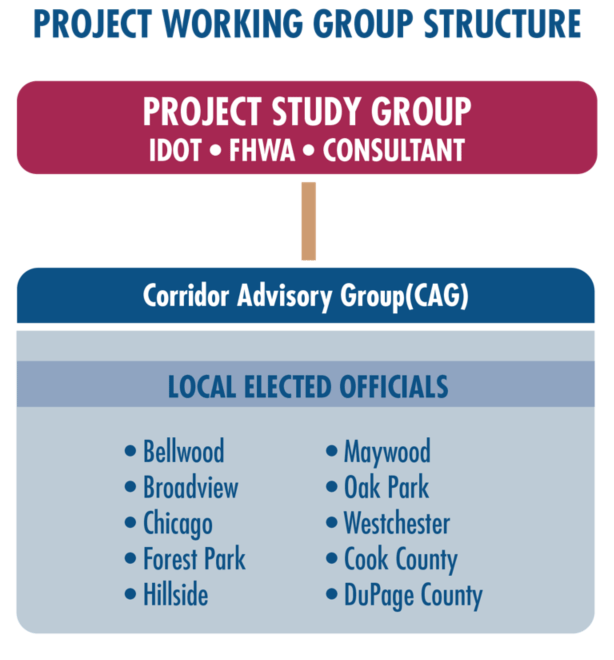Public Involvement Program/CSS
IDOT designated the I-290 study as a Context Sensitive Solutions (CSS) project which is a collaborative approach involving all stakeholders to develop a project that fits into its surroundings and preserves scenic, aesthetic, historic, and environmental resources while maintaining safety and mobility. The purpose of CSS is to gather and consider input on the project from all interested stakeholders. Public involvement is a key component of CSS and is strongly encouraged during this study. IDOT proactively sought stakeholder input and developed to assist with identifying solutions for this study area.
A stakeholder is anyone who could be affected by the project and has a stake in its outcome. Stakeholders are identified as all residents of the study area, users of the facility, and those interested parties who can directly affect the outcome of a planning process.
A Stakeholder Involvement Plan (SIP) was prepared for this project and was used as a blueprint that defined the methods and tools to educate and engage all stakeholders in the decision-making process for this project.Involvement Tools
Corridor Advisory Group
The CAG was comprised of local elected officials from each of the eight communities in the Study Area and the Chairmen or representatives from Cook and DuPage counties. The responsibility of the CAG was to review study information presented and provide input to help guide the development and evaluation of solutions in this corridor.

View a larger version of the Project Working Group Structure [pdf / 110 kb]
Public Outreach Meetings
Various meetings were held throughout the project development process providing input opportunities for all stakeholders and included:
- Small Group Meetings: Small group meetings that engaged stakeholders to share information and fostered conversations to address specific project issues, allowing for more specialized discussions and input, and aided the general public in better understanding the project goals and objectives.
- Agency & Municipal Meetings: Agency and Municipal meetings were held to discuss and coordinate specific project issues with those that would be impacted by the project.
- Speakers' Bureau: The speakers' bureau consisted of IDOT and Consultant staff and was assembled as needed or requested to present project-related information to interested local civic or service organizations.
Public Meetings: Public meetings and Town Hall Meetings were held at key points during the supplemental studies to engage the public. The purpose of the meetings was to solicit the viewpoints and opinions of those who participated regarding the information presented. Questions raised by meeting participants, depending on the nature, were either answered immediately or addressed in subsequent meetings, newsletters or other communication mechanisms. Public meetings were generally presented overall study information, town hall meetings were more focused and intended to work though community specific concerns.
Comments received at these meetings were documented and the information was considered a part of the analysis and evaluation of the improvement alternatives. Individuals on the mailing list received invitations in the mail announcing meeting information.Other Public Involvement Opportunities
In addition to the meeting opportunities described in the preceding section, several other methods were used to obtain information from the public about the project. These methods (noted below) provided information and opportunities for feedback regarding forthcoming public meeting events, project schedule, and provided general project status updates within the study area.
- Mailing List and e-subscription: To support public meeting invitations, newsletter distribution and other direct public contact, a mailing was developed including, mailing addresses, phone numbers and e-mail addresses per each person's preferences. If you would like to be added to the mailing list to receive project printed collateral or to receive electronic notices about website updates and/or project updates, please fill out the mailing list form.
- Newsletters: Newsletters are study publications that featured the latest project news and are used as a means of communicating information about the project and status in general.
- Comment and Mailing List Form: Please fill out a comment form, as we are interested in your thoughts and ideas. Additionally, if you would like to receive project newsletters and other mailings, please fill out the mailing list form.
